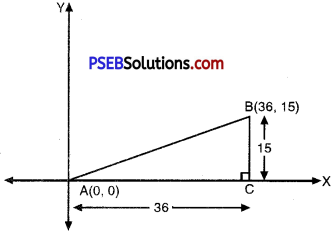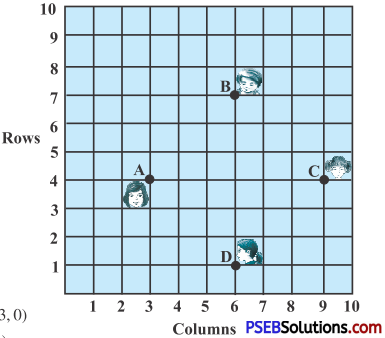Punjab State Board PSEB 10th Class Maths Book Solutions Chapter 7 Coordinate Geometry Ex 7.1 Textbook Exercise Questions and Answers.
PSEB Solutions for Class 10 Maths Chapter 7 Coordinate Geometry Ex 7.1
Question 1.
Find the distance between the following pairs of points:
(i) (2, 3); (4, 1)
(ii)(-5, 7); (-1, 3)
(iii) (a, b); (-a, -b).
Solution:
(i) Given points are: (2, 3); (4, 1)
Required distance = \(\sqrt{(4-2)^{2}+(1-3)^{2}}\)
\(\sqrt{4+4}=\sqrt{8}=\sqrt{4 \times 2}\)
= 2√2.
![]()
(ii) Given points are: (-5, 7); (-1, 3)
Required distance = \(\sqrt{(-1+5)^{2}+(3-7)^{2}}\)
\(\sqrt{16+16}=\sqrt{32}\)
= \(\sqrt{16 \times 2}\)
= 4√2.
(iii) Given points are: (a, b); (-a, -b)
Required distance = \(\sqrt{(-a-a)^{2}+(-b-b)^{2}}\)
= \(\sqrt{(-2 a)^{2}+(-2 b)^{2}}\)
= \(\sqrt{4 a^{2}+4 b^{2}}\)
= √4 \(\sqrt{a^{2}+b^{2}}\)
= \(2 \sqrt{a^{2}+b^{2}}\)
![]()
Question 2.
Find the distance between the points (0, 0) and (36, 15). Can you now find the distance between the two towns A and B
discussed in section 7.2.
Solution:
Given points are: A (0, 0) and B (36, 15)
Distance, AB = \(\sqrt{(0-36)^{2}+(0-15)^{2}}\)
\(\sqrt{1296+225}=\sqrt{1521}\) = 39.
According to Section 7.2
Draw the distinct points A (0, 0) and B (36, 15) as shown in figure.

Draw BC ⊥ on X-axis.
Now, In rt. ∠d ∆ACB,
AB = \(\sqrt{\mathrm{AC}^{2}+\mathrm{BC}^{2}}\)
= \(\sqrt{(36)^{2}+(15)^{2}}\)
= \(\sqrt{1296+225}=\sqrt{1521}\)
= 39.
Hence, required distance between points is 39.
![]()
Question 3.
Determine if the points (1, 5), (2, 3) and (- 2, – 11) are collinear.
Solution:
Given point are : A (1. 5); B (2.3) and C (- 2, – 11).
AB = \(\sqrt{(2-1)^{2}+(3-5)^{2}}\)
= \(\sqrt{1+4}=\sqrt{5}\)
BC = \(\sqrt{(-2-2)^{2}+(-11-3)^{2}}\)
= \(\sqrt{16+196}=\sqrt{212}\)
CA = \(\sqrt{(1+2)^{2}+(5+11)^{2}}\)
= \(\sqrt{9+256}=\sqrt{265}\)
From above distances, it is clear that sum of any two is not equal to third one.
Hence, given points are not collinear
Question 4.
Check whether (5, – 2); (6, 4) and (7, – 2) are the Vertices of an isosceles triangle.
Solution:
Given points be A (5, – 2); B (6, 4) and C (7, – 2).
AB = \(\sqrt{(5-6)^{2}+(-2-4)^{2}}\)
= \(\sqrt{1+36}=\sqrt{37}\)
BC = \(\sqrt{(6-7)^{2}+(4+2)^{2}}\)
= \(\sqrt{1+36}=\sqrt{37}\)
CA = \(\sqrt{(7-5)^{2}+(-2+2)^{2}}\)
= \(\sqrt{4+0}=2\)
From above discussion, it is clear that AB = BC = √37.
Given points are vertices of an isosceles triangle.
![]()
Question 5.
In a classroom, 4 friends are seated at the points A, B, C and D as shown in fig. Champa and Charnel walk into the class and after observing for a few minutes Champa asks Chameli, “Don’t you think ABCD is a square”? Chameli disagrees. Using distance formula, find which of them is correct, and why?

Solution:
In the given diagram, the vertices of given points are : A (3, 4); B (6, 7); C (9, 4) and D (6, 1).
Now,
AB = \(\sqrt{(6-3)^{2}+(7-4)^{2}}\)
= \(\sqrt{9+9}=\sqrt{18}\)
BC = \(\sqrt{(9-6)^{2}+(4-7)^{2}}\)
= \(\sqrt{9+9}=\sqrt{18}\)
CD = \(\sqrt{(6-9)^{2}+(1-4)^{2}}\)
= \(\sqrt{9+9}=\sqrt{18}\)
DA=\(\sqrt{(3-6)^{2}+(4-1)^{2}}\)
= \(\sqrt{9+9}=\sqrt{18}\)
AC = \(\sqrt{(9-3)^{2}+(4-4)^{2}}\)
= \(\sqrt{36+0}=6\)
BD = \(\sqrt{(6-6)^{2}+(1-7)^{2}}\)
= \(\sqrt{0+36}\) = 6
From above discussion, it is clear that
AB = BC = CD = DA = √18 and AC = BD = 6.
ABCD formed a square and Champa is correct about her thinking.
![]()
Question 6.
Name the type of quadrilateral formed, if any, by the following points, and give reasons for your answer:
(i) ( 1,- 2), (1, 0),(- 1, 2), (- 3, 0)
(ii) ( 3, 5), (3, 1), (0, 3), (- 1, – 4)
(iii) (4, 5), (7, 6), (4, 3), (1, 2).
Solution:
(i) Given points be A (- 1, – 2); B(1, 0); C(- 1, 2) and D(- 3, 0).
AB = \(\sqrt{(1+1)^{2}+(0+2)^{2}}\)
= \(\sqrt{4+4}=\sqrt{8}\)
BC = \(\sqrt{(-1-1)^{2}+(2-0)^{2}}\)
= \(\sqrt{4+4}=\sqrt{8}\)
CD = \(\sqrt{(-3+1)^{2}+(0-2)^{2}}\)
= \(\sqrt{4+4}=\sqrt{8}\)
DA = \(\sqrt{(-1+3)^{2}+(-2+0)^{2}}\)
= \(\sqrt{4+4}=\sqrt{8}\)
AC = \(\sqrt{(-1+1)^{2}+(2+2)^{2}}\)
= \(\sqrt{0+16}=4\)
BD = \(\sqrt{(-3-1)^{2}+(0-0)^{2}}\)
= \(\sqrt{16+0}=4\)
From above discussion, it is clear that
AB = BC = CD = DA = √8 and AC = BD = 4.
Hence, given quadrilateral ABCD is a square.
![]()
(ii) Given points be A (- 3, 5); B (3, 1); C (0, 3) and D (- 1,- 4)
AB = \(\sqrt{(-3-3)^{2}+(5-1)^{2}}\)
= \(\sqrt{36+16}=\sqrt{52}=\sqrt{4 \times 13}\)
= 2√13
BC = \(\sqrt{(3-0)^{2}+(1-3)^{2}}\)
= \(\sqrt{9+4}=\sqrt{13}\)
CA = \(\sqrt{(0+3)^{2}+(3-5)^{2}}\)
= \(\sqrt{9+4}=\sqrt{13}\)
Now, BC + CA = \(\sqrt{13}+\sqrt{13}\) = 2√13 = AB
∴A, B and C are collinear then A, B, C and D do not form any quadrilateral.
(iii) Given points are A (4, 5); B (7, 6); C (4, 3) and D (1, 2)
AB = \(\sqrt{(7-4)^{2}+(6-5)^{2}}\)
= \(\sqrt{9+1}=\sqrt{10}\)
BC = \(\sqrt{(4-7)^{2}+(3-6)^{2}}\)
= \(\sqrt{9+9}=\sqrt{18}=3 \sqrt{2}\)
CD = \(\sqrt{(1-4)^{2}+(2-3)^{2}}\)
= \(\sqrt{9+1}=\sqrt{10}\)
DA = \(\sqrt{(4-1)^{2}+(5-2)^{2}}\)
= \(\sqrt{9+9}=\sqrt{18}=3 \sqrt{2}\)
AC = \(\sqrt{(4-4)^{2}+(3-5)^{2}}\)
= \(\sqrt{0+4}\) = 2
BD = \(\sqrt{(1-7)^{2}+(2-6)^{2}}\)
= \(\)
From above discussion, it is clear that AB = CD and BC = DA. and AC ≠ BD.
i.e., opposite sides are equal but their diagonals are not equal.
Hence, given quadrilateral ABCD is a parallelogram.
![]()
Question 7.
Find the points on the x-axis which is equidistant from (2, – 5) and (- 2, 9).
Solution:
Let required point be P (x, 0) and given points be A (2, – 5) and B (- 2, 9).
According to question,
PA = PB
(PA)2 = (PB)2
or (2 – x)2 + (- 5- 0)2 = (- 2 – x)2 + (9 – 0)2
or 4 + x2 – 4x + 25 = 4 + x2+ 4x + 81
-8x = 56
x = \(\frac{4}{4}\) = – 7
Hence, required point be (- 7, 0).
Question 8.
Find the values of y for which the distance between the points P (2, – 3) and Q (10, y) is 10 units.
Solution:
Given points are P (2, – 3) and Q (10, y)
PQ = \(\sqrt{(10-2)^{2}+(y+3)^{2}}\)
= \(\sqrt{64+y^{2}+9+6 y}\)
= \(\sqrt{y^{2}+6 y+73}\)
According to question,
PQ = 10
or \(\sqrt{y^{2}+6 y+73}\) = 10
Squaring
or y2 + 6y + 73 = 100
or y2 + 6y – 27 = 0
or y2 + 9y – 3y – 27 = 0
S = 6 P = – 27
or y (y + 9) – 3 (y + 9) = 0
or (y + 9) (y – 3) = 0
Either y + 9 = 0 or y – 3 = 0
y = – 9 or y = 3
Hence, y = – 9 and 3.
![]()
Question 9.
If Q (0, 1) is equidistant from P (5, – 3) and R (x, 6), find the values of x. Also find the distances QR and PR.
Solution:
Given points Q (0, 1); P (5, – 3) and R (x, 6)
QP = \(\sqrt{(5-0)^{2}+(-3-1)^{2}}\)
= \(\sqrt{25+16}=\sqrt{41}\)
and QR = \(\sqrt{(x-0)^{2}+(6-1)^{2}}\)
= \(\sqrt{x^{2}+25}\)
According to question,
QP = QR
or \(\sqrt{41}=\sqrt{x^{2}+25}\)
Squaring
or 41 = x2 + 25
or x2 = 16
or x = ± √16 = ± √4.
When x = 4 then R (4, 6).
QR = \(\sqrt{(4-0)^{2}+(6-1)^{2}}\)
= \(\sqrt{16+25}=\sqrt{41}\)
PR = \(\sqrt{(4-5)^{2}+(6+3)^{2}}\)
= \(\sqrt{1+81}=\sqrt{82}\)
When x = – 4 then R (- 4, 6).
QR = \(\sqrt{(-4-0)^{2}+(6-1)^{2}}\)
= \(\sqrt{16+25}=\sqrt{41}\)
PR = \(\sqrt{(-4-5)^{2}+(6+3)^{2}}\)
= \(\sqrt{81+81}=\sqrt{162}\).
![]()
Question 10.
Find a relation between x and y such that the point (x, y) is equidistant from the point (3, 6) and (- 3, 4).
Solution:
Let required points be P (x, y) and given points are A (3, 6) and B (- 3, 4)
PA = \(\sqrt{(3-x)^{2}+(6-y)^{2}}\)
= \(\sqrt{9+x^{2}-6 x+36+y^{2}-12 y}\)
= \(\sqrt{x^{2}+y^{2}-6 x-12 y+45}\)
and PB = \(\sqrt{(-3-x)^{2}+(4-y)^{2}}\)
= \(\sqrt{9+x^{2}+6 x+16+y^{2}-8 y}\)
= \(\sqrt{x^{2}+y^{2}+6 x-8 y+25}\)
According to question,
PA = PB
\(\sqrt{x^{2}+y^{2}-6 x-12 y+45}\) = \(\sqrt{x^{2}+y^{2}+6 x-8 y+25}\)
sq,. both sides, we have,
or x2 + y2 – 6x – 12y + 45 = x2 + y2 + 6x – 8y – 25
or -12x – 4y + 20 = 0
or 3x + y – 5 = 0 is the required relation.
